Following last week’s US CPI data, which showed that inflation in the US accelerated by more than anticipated, investors will be eager to find out whether this is the case in other major economies as well. Thus, they may pay extra attention to the UK and Canadian CPI data, where further acceleration could bring forth expectations with regards to rate hikes by the Bank of England (BoE) and the Bank of Canada (BoC).
Retail sales from those nations are also due to be released, but also from the US, with upbeat numbers indicating that the Fed could start raising rates as soon as tapering is over. On Monday, during the Asian morning, we got Japan’s preliminary GDP for Q3. The data showed that economic activity shrank 0.8% QoQ after expanding 0.4% in Q2. The forecast was for a 0.2% contraction.
This took the YoY rate down to -3.0% from +1.5%. At its latest gathering, the Bank of Japan (BoJ) kept its monetary policy settings untouched and downgraded its growth and inflation projections, while today, Governor Kuroda said that they will maintain their “powerful” easing strategy and stand ready to rump up stimulus if needed, even as other central banks have begun to, or are preparing to start, withdrawing pandemic-related policies.
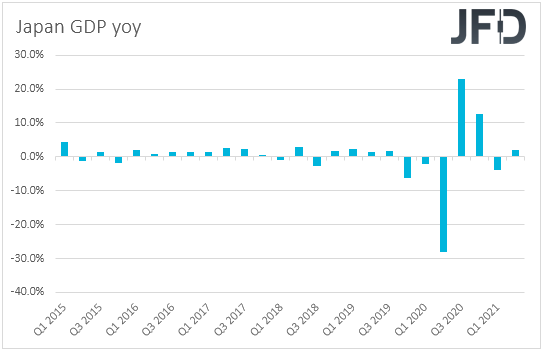
In our view, the GDP data will add to Kuroda’s view, and leave the yen exposed to another round of selling, despite its latest recovery. With the BoJ keeping a lid on Japanese government bond yields and other central banks moving towards higher rates, the yield differentials between Japan and other major nations could weigh against the yen.
China’s fixed-asset investment, industrial production, and retail sales for October are also out. Fixed asset investment slowed to +6.1% YoY from +7.3%, while industrial production and retail sales surprisingly accelerated, instead of slowing down as their own forecasts suggested. Specifically, they accelerated to +3.5% YoY and +4.9% YoY from +3.1% and +4.4% respectively.
The data may be a relief following the latest evidence of a slowing economy, but the deepening debt crisis in the property sector leaves no room for celebration. Despite not affecting the overall global market sentiment, this has left marks in the morale of Asian investors, and this is distinct by the fact that Asian equity indices continue to underperform their European and US peers.
Later in the day, we get the New York Empire State manufacturing index for November, which is expected to have increased to 21.60 from 19.80. This may be a first indication over which direction the official manufacturing index for the whole nation may take and could add credence to the view that the latest bottlenecks have not affected the US economy as much as initially thought.
On Tuesday, during the Asian session, the Reserve Bank of Australia (RBA) will release the minutes from its latest meeting, where it maintained its core policies – rates and QE – unchanged but decided to discontinue the 10 bps April 2024 yield target, something that was obvious, after they failed to defend that level the week before.
They also abandoned the forward guidance that interest rates are most likely to stay unchanged at least until 2024 and suggested that this could happen in 2023. At the press conference following the decision, Governor Lowe said that the latest data and forecasts do not warrant an increase in the cash rate in 2022.
However, according to the ASX 30-day interbank cash rate futures yield curve, the market still anticipates a 15 bps hike in June next year and sees rates getting very close to 1% in December. Therefore, stronger hints that the RBA is not planning to touch the rate next year could hurt the Aussie again.
As we noted after the meeting, with expectations around interest rate hikes staying elevated, there is ample room for more disappointment, and thereby, more downside potential for the Australian currency.
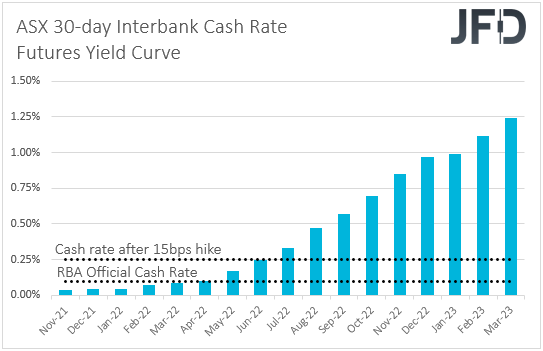
Later in the day, the UK employment report for September is expected to reveal that the unemployment rate has ticked down to 4.4% from 4.5% and that the employment change has added slightly fewer jobs in the three months to September than in the three months to August.
Average hourly earnings, both including and excluding bonuses, are expected to slow recently, but although this could be a relief indication for future inflation, market participants will continue biting their nails in anticipation of the UK CPIs for October, due out on Wednesday.
From the Eurozone, we get the 2nd estimate of the GDP for Q3, which is expected to confirm its preliminary print of 2.2%, as well as the bloc’s employment change for the quarter, for which no forecast is available though.
Later in the day, all the market attention may turn to the US retail sales for October, as well as the industrial and manufacturing production rates for the month. Headline sales are forecast to have accelerated to +1.1% MoM from +0.7%, while the core rate is expected to have held steady at +0.8% mom. Industrial and manufacturing productions are expected to have rebounded 0.7% MoM and 0.8% MoM, after sliding 1.3% and 0.7% respectively.
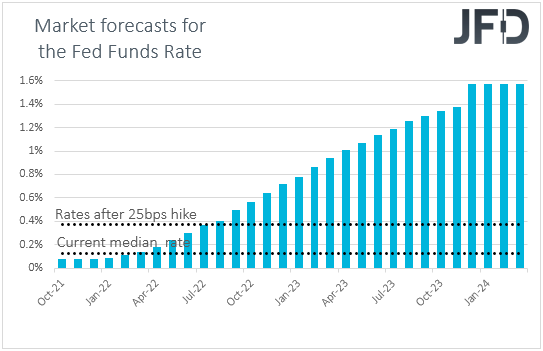
In our view, the forecasts point to decent data, which following last week’s acceleration in the US CPIs could increase bets over a hike by the Fed as soon as the tapering process is over. Remember that at the latest gathering, Fed Chair Powell said that they will stay “patient” on interest rates, but he did not close the door on the likelihood of action just after tapering is over.
According to the Fed funds futures, investors are already pricing in a 25 bps hike to be delivered in July or August next year, and another round of strong US data could add more credence to their view. This is likely to allow more dollar buying, but in terms of how the equities will react, there is still some uncertainty.
Will they slide on speculation that faster rate hikes will hurt the profitability of firms, or will they rise on indications that the economy is performing better than previously thought? Although the former was the case in the past, we believe that now it is the latter, and thus, even if equities are correct somewhat, we expect a rebound very soon. After all, market participants may have already digested the idea of higher rates soon.
On Wednesday, following the acceleration in the US CPIs last week, market participants may be sitting on the edge of their seats in anticipations of more inflation numbers. We do get data for October from the UK, the Eurozone, and Canada. However, Eurozone’s numbers will be the final ones, which are just expected to confirm their initial estimates.
In the UK, expectations are for the headline rate to jump to +3.9% YoY from +3.1%, while the core one is expected to rise to +3.1% YoY from +2.9%. At its latest meeting, the BoE decided not to hike, despite market participants assigning an 80% chance for such a move ahead of the meeting, and instead said that this could happen in “coming months”.
Last Monday, the pound rebounded strongly, following remarks by BoE Governor Andrew Bailey, who said that they are on a path towards raising interest rates, which may have sparked expectations over a December move. However, on Thursday, the preliminary UK GDP for Q3 disappointed, slowing by more than expected.
This may have forced market participants to push back their hike expectations, perhaps somewhere in the first months of next year. After all, February is also in the “coming months” spectrum. Having said all that though, strong acceleration in consumer prices will add credence to Governor’s Baily remarks and may revive speculation for a December hike.
This is likely to prove positive for the pound. The big question here is whether GBP traders are still trusting Bailey, who ahead of the prior meeting has been adding to hopes over a hike, but instead was among those supporting standing pat.
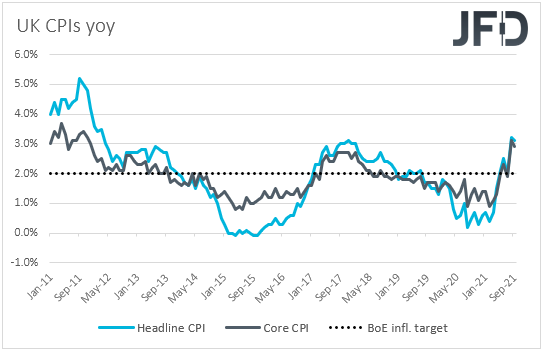
Now, passing the ball to Canada, the headline rate is expected to continue rising, to +4.6% YoY from +4.4%, while no forecast is available for the core one. With the Bank of Canada (BoC) unexpectedly ending its QE program at its latest meeting, officials may be now looking for the appropriate time to increase interest rates.
Around 10 days ago, the employment data revealed a slowdown in jobs growth, but also a slide in the unemployment rate. We don’t believe that this may have affected expectations around a hike early next year much, and further acceleration in inflation could strengthen the case, providing some support to the Canadian dollar.
That said, we are reluctant to call for a long-lasting recovery and this is due to the latest slide in oil prices. Remember that Canada is a major oil-producing and exporting nation, and thereby, the Loonie is correlated to prices of the oil.
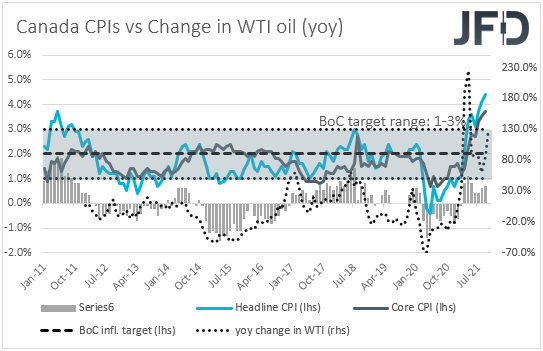
On Thursday, there are no major events or indicators on the financial agenda. Finally, on Friday, Asian time, Japan releases its National CPIs for October.
No forecast is available for the headline rate, while the core one is anticipated to have held steady at +0.1% YoY, well below the BoJ’s objective of 2%. In our view, this is likely to add more credence to the BoJ’s stance of maintaining its policy extra loose.
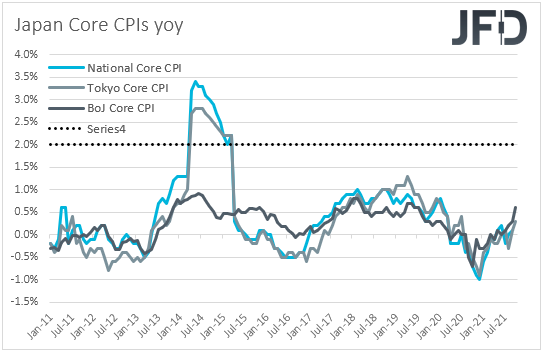
Later in the day, we get retail sales data from the UK and Canada, for the months of October and September respectively. In the UK, both headline and core sales are expected to rebound after sliding in September, which could add to expectations over a December hike by the BoE if indeed inflation keeps accelerating on Wednesday.
In Canada, headline sales are forecast to have fallen, but core sales are anticipated to have risen at the same pace as in August. Given that this is September data and that on Wednesday, we get October CPIs, we don’t expect any major market reaction.
